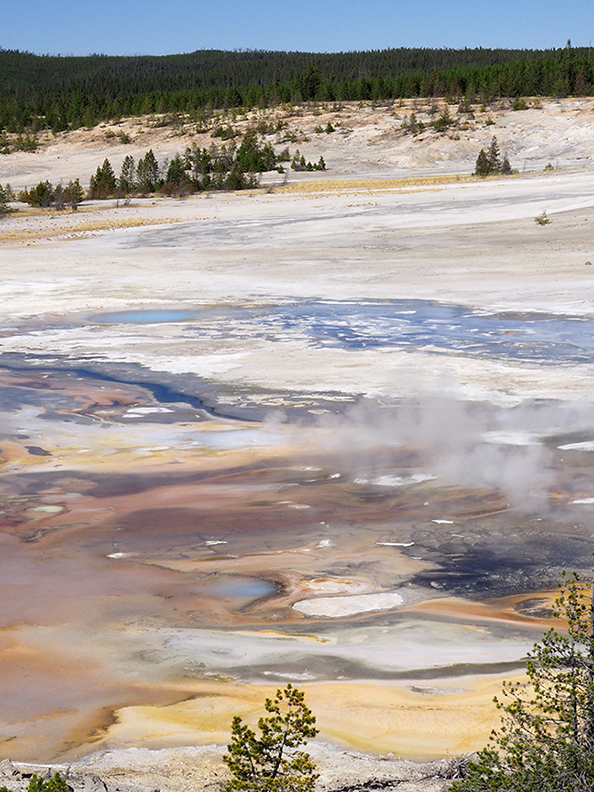
This too is Yellowstone

Buffalo herd by the Madison River

Through the windshield
My second full day in Yellowstone started with a traffic jam. After half an hour of inching along the road, I finally saw the reason for the hold-up: A entire herd of buffaloes was moving east between the road and the Madison River. Some of the buffaloes had found a nice place to roll cumbrously in the dust. Two males decided to spar. And I spotted a still-reddish baby buffalo in the group. If I’d been sitting in the passenger seat I could have reached out and touched some of these animals. As it was, for many of the photos I took I had to hold the camera up high to keep buffalo heads from being obscured by the door frame. And so, like everyone else on the road, I contributed to the traffic jam.
After the buffalo jam I hoped to visit a favorite of mine, Grand Prismatic Spring, but I gave up—cars spilled over from the parking lot all the way to the main road and more. Instead I spent an hour or so on Firehole Lake Drive, where there were few people but several interesting geysers and pools.
In the meadow between the geyser area and Firehole Lake, I stopped by this small stream and dipped my hand into the water. The morning was in the 40s, but the water was quite warm from the geyser runoff.

Stream, Firehole Lake Drive
Eventually I drove south to West Thumb Geyser Basin, on the edge of Yellowstone Lake. From here you can see hot springs, geysers, the lake, and the distant mountains all in the same view. It was tough to get people-free shots here, because the boardwalks were crowded with selfie-taking tourists—a people jam. But it was worth the jostling to see the lake and the brilliant colors of the two pools below, the most beautiful at West Thumb.
I walked twice as far as I expected to at West Thumb. As I was heading back to the car from the lake, a ranger closed the boardwalk ahead of me because a group of elk were getting too close to the crowds, or vice versa. I backtracked along the lake all the way around to the other side of the basin—where people also were, you guessed it, being turned back toward the lake because of a large bull elk. So I backtracked over my backtrack and found a middle route up the slope.
At this point my feet were aching and I was extremely glad that I’d packed cheese and crackers and grapes in the car. Despite the crowds, some of the restaurants in Yellowstone had already closed for the season. After my early picnic supper, I drove down to Teton National Park, where the blinding sun just before sunset rendered the mountains extremely hazy. The photo below, considerably tinkered with in Photoshop, was the best I could do, which is not saying much. After getting lost a bit, I discovered that my motel for the evening—actually a cabin at the Togwotee Mountain Lodge—was about 15 miles east. And so I ended up not really seeing the Tetons on this trip. After several sleepless nights and lots of walking, I knew I needed to head home the next day.

Tetons at sunset
But in the morning, before continuing east, I drove back about five miles west for a last glimpse of the mountains. And a wonderful visual effect occurred: As I rounded a curve, a mountain came into view on the horizon. Then another one, taller. Then another one, still taller. As the road continued curving, to my astonishment yet another mountain, massively tall, appeared. The Tetons are familiar to most Americans from countless movies and photographs. I’ve seen them on a couple of previous trips. Yet, like the Grand Canyon, they surprise you every time in person. I hope to go back.

Distant view of Tetons


























